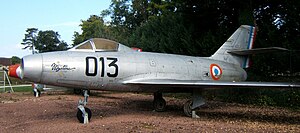| MD.452 Mystère | |
|---|---|
| Role | Fighter-bomber |
| Manufacturer | Dassault Aviation |
| First flight | 1951 |
| Introduced | 1954 |
| Retired | 1963 (France) |
| Primary user | French Air Force |
| Produced | 1951-1957 |
| Number built | 166 |
Contents
|
Development
After the success of the Ouragan, Dassault was working on a more advanced machine based on it, which would take to the air in early 1951 as the MD.452 Mystère I.The first prototype Mystere I was essentially an Ouragan with a 30-degree swept wing and modified tail surfaces. Two further prototypes followed, powered by the Rolls-Royce Tay 250 centrifugal-flow turbojet, an improved version of the Rolls-Royce Nene, built under license by Hispano-Suiza, and rated at 28.0 kN (2,850 kp / 6,280 lbf) thrust.
These three Mystere I prototypes led to two Mystere IIA prototypes, powered by the Tay and armed with four Hispano 20 mm cannon; and then four Mystere IIB prototypes, which traded the four 20 millimeter cannon for two 30 millimeter DEFA revolver-type cannon. A Mystere IIA was the first French aircraft to break Mach 1 in controlled flight (in a dive), on 28 October 1951.
The eleven pre-production machines that followed were designated Mystere IIC, nine of which were fitted with the SNECMA Atar 101C axial-flow turbojet, rated at 24.5 kN (2,500 kp / 5,510 lbf) thrust, while two were experimentally fitted with the afterburning Atar 101F, with afterburning thrust of 37.3 kN (3,800 kp / 8,380 lbf).
Operational history
The French Air Force ordered 150 Mystere IICs, with the first production machine flying in June 1954, and delivered in October of that year. The production aircraft featured the twin 30 mm DEFA cannon, an Atar 101D turbojet with 29.4 kN (3,000 kp, 6,615 lbf) thrust, increased tail sweep, and revised intake trunking and internal fuel tank arrangement. Top speed was 1,030 km/h (640 mph) at low level. Details of external stores are unclear, but a reasonable assumption would be that they were similar to those of Ouragan.The last Mystere IIC was delivered in 1957, by which time the type was already being relegated to advanced training duties. Aircraft design was moving at a breakneck pace in the 1950s and even as the Mystere IIC was becoming operational, the better Dassault Mystere IVA was flying. The Mystere IIC was very much an interim type, though it did persist in the training role until 1963.
There were no foreign buyers for the Mystere II. As noted, the Israelis wanted to buy 24 but changed their minds and bought Mystere IVAs instead. It appears that the Mystere II was never used in combat.
Variants
There was only a single Mystere III, or more precisely Mystere IIIN, derived from experiments with the Ouragan. One of the original Ouragan prototypes had been built as a demonstrator for a night fighter, with a solid nose containing air intercept radar and the air intakes moved to the side of the aircraft, under the cockpit. It was fitted with twin 30 mm DEFA cannon and designated "MD 350-30-L", with the "30" meaning the 30 mm guns and the "L" meaning the lateral intakes.The modified Ouragan retained its single-seat configuration. It was intended to lead to a two-seat night fighter, the "MD 451", but the development of the Mystere II made it more attractive to develop a two-seat version of the Mystere II instead.
Operators
Specifications (Mystère IIC)
General characteristics- Crew: 1
- Length: 11.7 m (38 ft 6 in)
- Wingspan: 13.1 m (42 ft 9 in)
- Height: 4.26 m (14 ft)
- Wing area: 30.3 m² (326 ft²)
- Empty weight: 5,225 kg (11,520 lb)
- Max takeoff weight: 7,475 kg (16,480 lb)
- Powerplant: 1× SNECMA Atar 101D turbojet, 29.4 kN (6,620 lbf)
- Maximum speed: 1,060 km/h (575 knots, 660 mph)
- Range: 885 km (480 NM, 550 mi)
- Service ceiling: 15,250 m (50,000 ft)
- Rate of climb: 23 m/s (4,530 ft/min)
- Guns: 2× 30 mm (1.18 in) DEFA cannons with 150 rounds per gun
- Rockets: 2× Matra rocket pods with 18× SNEB 68 mm rockets each
- Bombs: 900 kg (2,000 lb) of payload on four external hardpoints, including a variety of bombs or Drop tanks



No comments:
Post a Comment